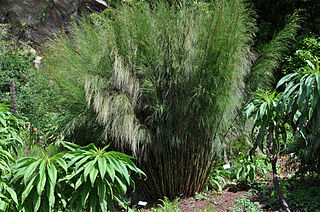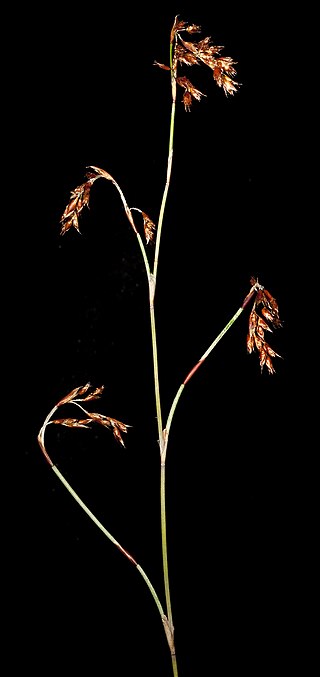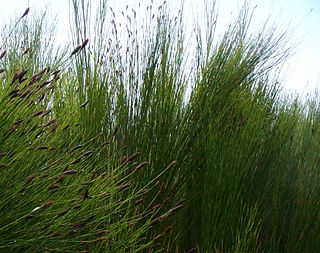
The Restionaceae, also called restiads and restios, are a family of flowering plants native to the Southern Hemisphere; they vary from a few centimeters to 3 meters in height. Following the APG IV (2016): the family now includes the former families Anarthriaceae, Centrolepidaceae and Lyginiaceae, and as such includes 51 genera with 572 known species. Based on evidence from fossil pollen, the Restionaceae likely originated more than 65 million years ago during the Late Cretaceous period, when the southern continents were still part of Gondwana.
Antitropicaldistribution is a type of disjunct distribution where a species or clade exists at comparable latitudes across the equator but not in the tropics. For example, a species may be found north of the Tropic of Cancer and south of the Tropic of Capricorn, but not in between. With increasing time since dispersal, the disjunct populations may be the same variety, species, or clade. How the life forms distribute themselves to the opposite hemisphere when they can't normally survive in the middle depends on the species; plants may have their seed spread through wind, animal, or other methods and then germinate upon reaching the appropriate climate, while sea life may be able to travel through the tropical regions in a larval state or by going through deep ocean currents with much colder temperatures than on the surface. For the American amphitropical distribution, dispersal has been generally agreed to be more likely than vicariance from a previous distribution including the tropics in North and South America.
Reynaudia is a genus of plants in the grass family. The only known species is Reynaudia filiformis, native to the Greater Antilles.

Willdenowia is a small genus of flowering plants in the family Restionaceae described as a genus in 1790. The entire genus is endemic to the fynbos of the Western Cape Province of South Africa.
Anthochortus is a group of plants in the Restionaceae described as a genus in 1837. The entire genus is endemic to Cape Province in South Africa.

Askidiosperma is a group of plants in the Restionaceae described as a genus in 1850. The entire genus is endemic to Cape Province in South Africa.

Cannomois is a group of plants in the Restionaceae described as a genus in 1828. The entire genus is endemic to Cape Province in South Africa.
Hydrophilus is a group of plants in the Restionaceae described as a genus in 1984.
Hypodiscus is a group of plants in the Restionaceae named by Christian Gottfried Daniel Nees von Esenbeck and described as a genus in 1836.
Mastersiella is a group of plants in the Restionaceae described as a genus in 1930.

Meeboldina is a plant genus in the family Restionaceae, described as a genus in 1943. It is named for the botanical collector Alfred Meebold.
Nevillea is a group of plants in the Restionaceae described as a genus in 1984. The entire genus is endemic to Cape Province in South Africa.

Platycaulos is a group of plants in the Restionaceae described as a genus in 1984. The genus is native to Africa including Madagascar.

Rhodocoma is a group of plants in the Restionaceae described as a genus in 1836. The entire genus is endemic to South Africa (Cape Province and KwaZulu-Natal.
Tenaxia is a genus of Asian and African plants in the grass family.
Geochloa is a genus of South African plants in the grass family.
Capeochloa is a genus of South African plants in the grass family. It contains three species of perennial grasses endemic to the Cape Provinces.

Ceratocaryum argenteum, commonly known as silver arrowreed, is a species of plant in the Restionaceae family and is native to the Cape Provinces of South Africa.








